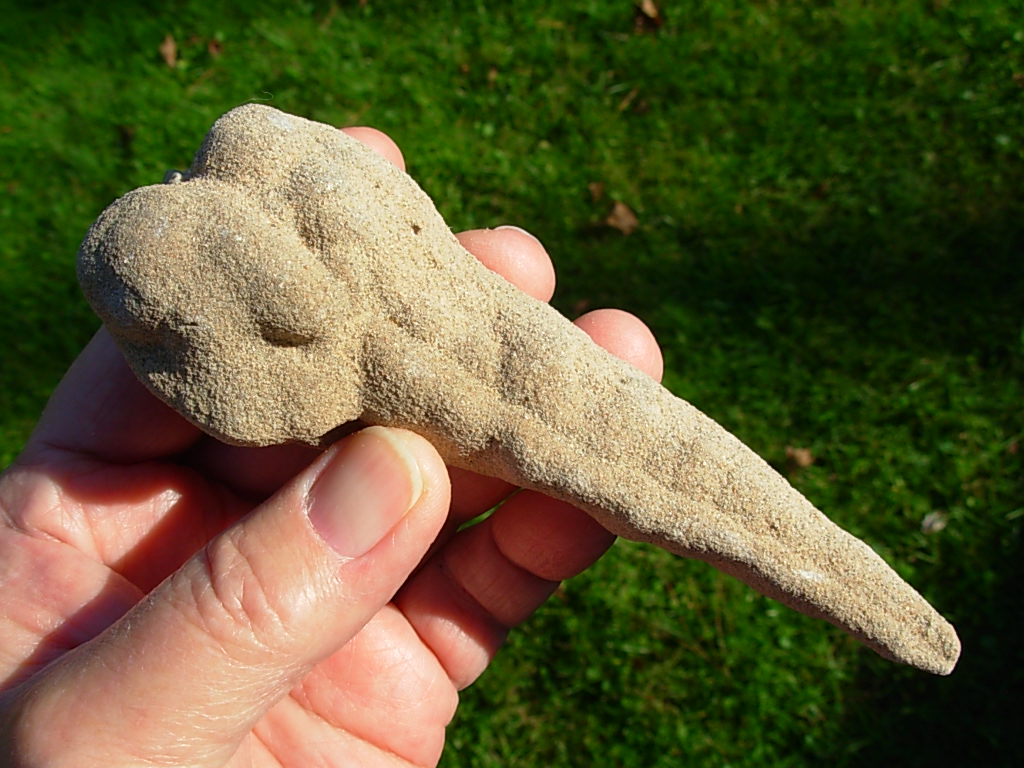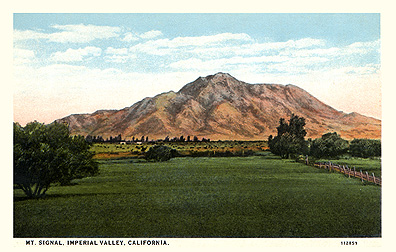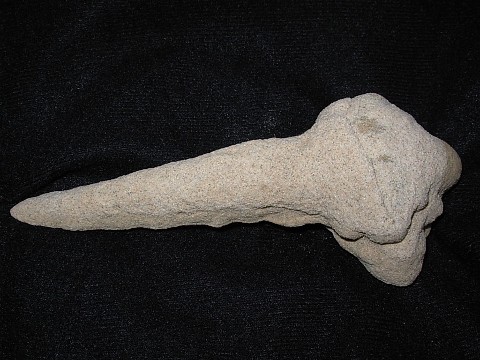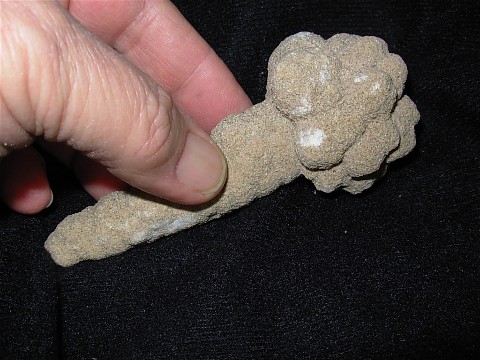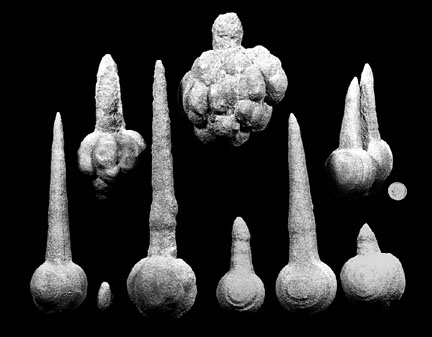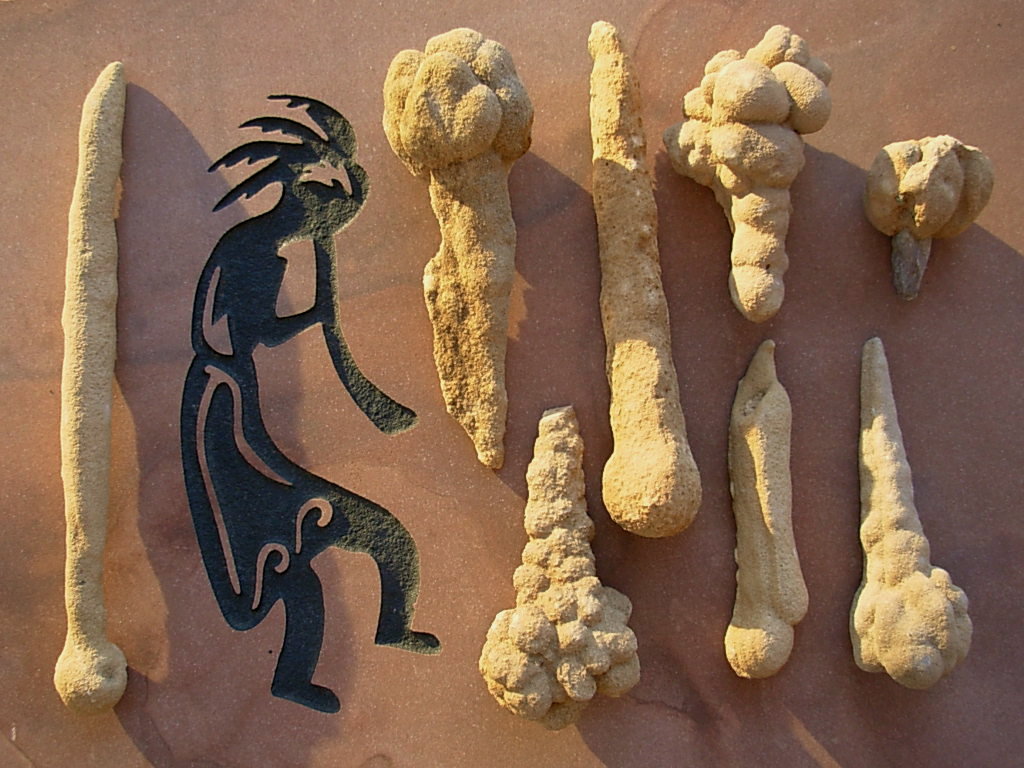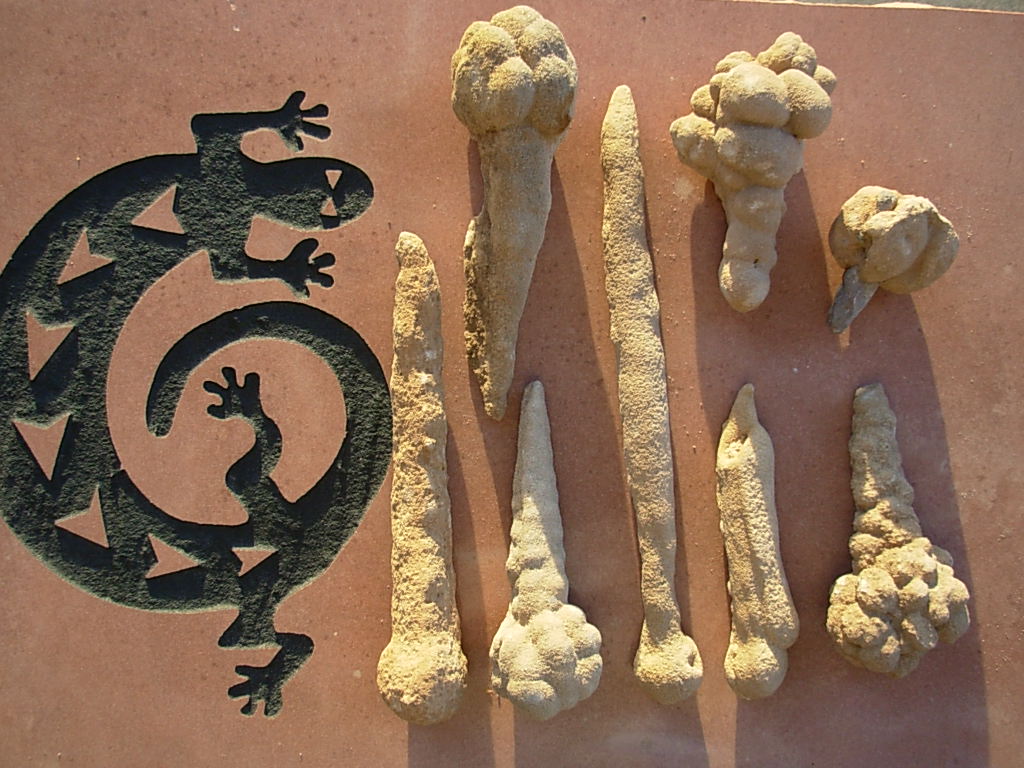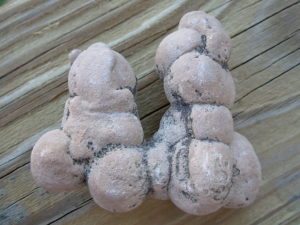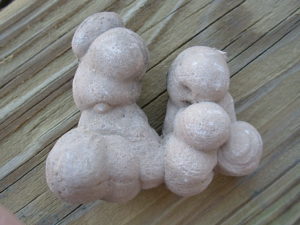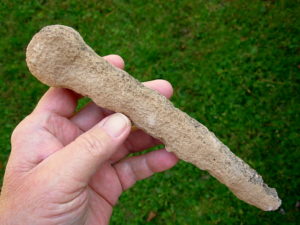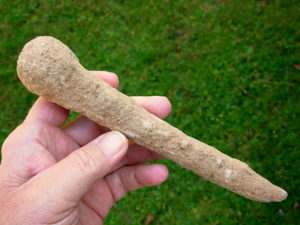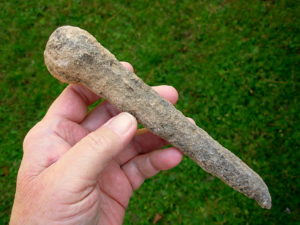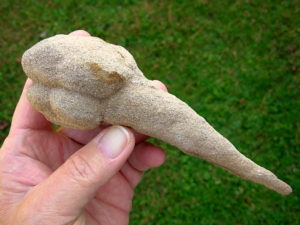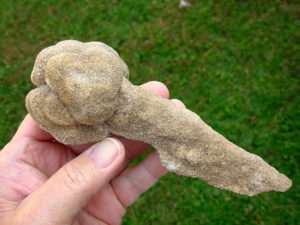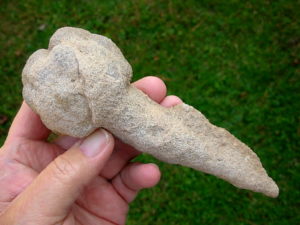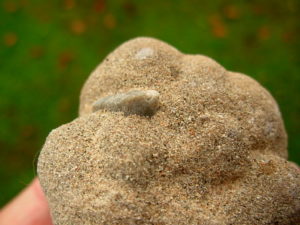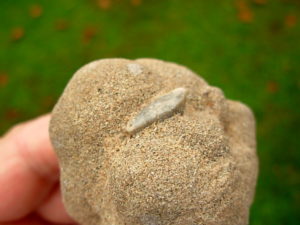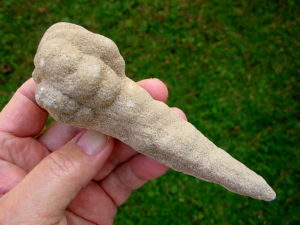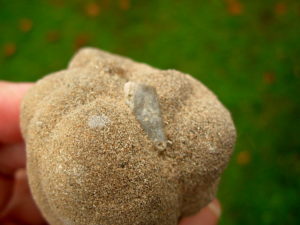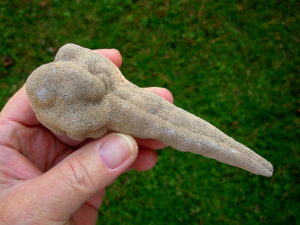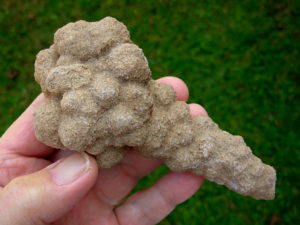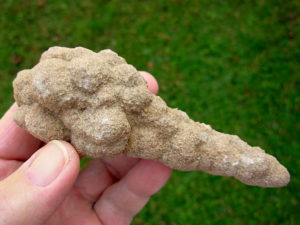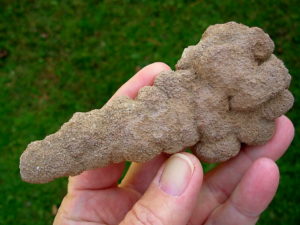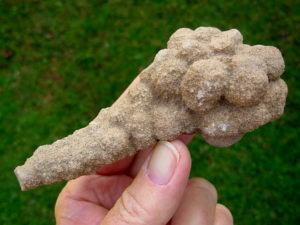Sand Spikes from Mount Signal
Sand Spikes (Sand Concretions) from Mount Signal
Excerpted from: Oddities of the Mineral World Van Nostrand Reinhold Company 1976. All rights reserved.
These strange concretions, called sand spikes, came from a now-depleted locality near the Mexican-American border close to Mt. Signal, Imperial County, California. The provocative formations of different sizes were discovered in beds of sand, and they all were found pointing to the west!!
THE SAND SPIKES FROM MOUNT SIGNAL by WILLIAM B. SANBORN
No discussion of concretions would be complete if mention were not made of a real puzzler, a truly unique type of concretion that apparently remains unexplained—sand spikes. The original locality is believed to have been discovered by Mr. H. W. Pierce of Laguna Beach, who amassed a fabulous collection of the fascinating formations and used them as trade items to assemble a very fine mineral collection. Mr. Pierce also made generous donations of these amazing formations to museums throughout the world. A few years ago my wife and I were visiting the superb mineral collection displayed at the museum of natural history museum in Lyon, France and were delighted to see a case devoted to sand spikes, courtesy of Mr. Pierce!
Briefly, the locality consisted of a series of low, sandy hillocks and banks near the Mexican-American border close to Mt. Signal, Imperial County, California. When they were first discovered, many of these unique concretions were weathering out on the surface of the ground. It became apparent, however, that there actually were beds of these strange concretions 3 feet to 8 feet underground! The following may be almost too much to believe, but, having collected at the locality before it was decimated, I can assure you it is quite accurate.
These concretions consist of a ball-like end coupled with a tapering spike-like formation. In uncovering a bed of spikes over 95 percent of the formations were found pointing west. Spikes of similar types or formats seemingly occurred in the same bed or within lens-like concentrations of the sand-spike formations. They range in size from over 11/2" to over 13" in length and occur in a wide variety of shapes—perfectly round with stubby or long, tapering spikes or knobby with rough spikes. The spikes were usually quite damp and broke easily when uncovered, so they were dried in the sun before being handled. They are composed of absolutely nothing but the identical sand forming the soft little hillocks and banks in which they occur—solid sandstone with no fossil material inside. The mineral cementing the grains together is apparently calcite.
What are they? No one really knows—other than they obviously fall under the heading of concretions by virtue of their method of occurrence and basic mineralogical composition. The long points, westerly oriented, are the most provocative aspect of this truly unique locality. There is no surrounding evidence in the area to indicate any realistic fossil origin. However there have been some truly far-out suggestions offered. Some say that they are fossils of an ancient type of bulbous seaweed that drifted heavy-end eastward on some ancient shoreline. Others have suggested that the have somehow been affected by an unknown magnetic force that oriented their westerly growth. It has also been suggested that they are some type of fulgurites, which is positively incorrect, and not by any stretch of the imagination are they prehistoric man-made artifacts.
In any event, it is always interesting to note that there are, indeed, geological formations that still remain surrounded by an aura of mystery. Incidentally, this locality has been totally exhausted by pick, shovel, and most unfortunately, bulldozer. The latter technique was very unsuccessful, essentially managing only to crush many hundreds of fine specimens.
Sand Spikes formed in the soils of Lake Cahuilla, an ancient sea that disappeared centuries ago. This geological oddity was once very common and very specific to the area. Over the last century, these concretions were excessively collected from the foot of Mount Signal, a mountain that long ago had been an island, straddling what is now the Valle Mexicali, Baja California, Mexico, and the Imperial Valley, California, U.S.A. Sadly, these sand spikes have now disappeared from the area entirely. The history of these natural wonders now lies in the hands of the storytellers and the lucky collectors who were able to find one of these oddities...so now it's in our hands!
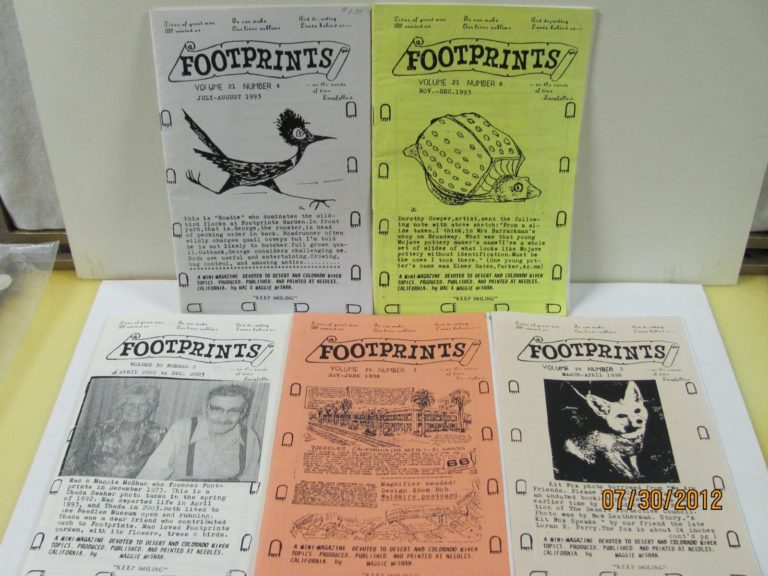
We were first introduced to these "Sand Spikes" by Maggie McShan in Needles, California. Chris was friends with Linda, a niece of Maggie's who introduced Chris to Maggie. As it turns out, Maggie and her husband Frank travelled to Needles on Route 66 in 1936 so he could work the mines near Needles. With a husband as a miner, rock collecting was a natural for "Mac" and Maggie. For 70 years they ran a rock shop in Needles. Maggie McShan was truly a terrific person. She and her husband started the publication "Footprints" a local publication in 1973 and published editions through 2003. Maggie was considered to be the historian of Needles and was extremely active in the restoration of the Route 66 Memories and especially the old Harvey House El Garces and the Railroad Bridge across the Colorado River to Arizona. Maggie has been quoted , written about and assisted in publishing Route 66 books, Bureau of Land Management Documentation and Needles Museum information.
Maggie gave Chris her first "Sand Spike" which we still have and will probably never part with...."Such a Wonderful Gift from such a Special Lady!" Maggie L Hargis McShan 1915-2004
Item # SS12200561
Rare Twin Mount Signal Sand Spike

Rare Twin Mount Signal Sand Spike
This specimen weighs 2.82 oz or 0.17 lbs (80.5g) and measures 2.7 x 2.4 x 0.95" (6.8 x 6.2 x 2.4 cm) with roundish shaped heads. A rare find to add to your collection! These are almost impossible to find anymore, supply has been depleted for over 40 yrs.
Item # SS1112S34C5571
Rare 8 inch Mount Signal Sand Spike

Rare 8" (20.5cm) Mount Signal Sand Spike
This specimen weighs 8.4 oz or 0.52 lbs (238g) and measures @ 8" (20.5cm) long with roundish shaped head to 1.63" (41.5mm) wide. Has an interesting dark side from ground contact. A rare find to add to your collection! These are almost impossible to find anymore, supply has been depleted for over 36 yrs.
Item # SS1112S64C6571
Very Rare 6.7 inch Mount Signal Cauliflower Sand Spike "Blade"

Very Rare 6.7" Mount Signal Cauliflower Sand Spike "Blade"
This specimen weighs 10.7 oz or 0.67 lbs (305g) and measures 6.77" (17.1cm) long with Cauliflower shaped head 2.45" (62mm) wide. Has a Rare knife blade shape. A very rare find to add to your collection! These are almost impossible to find anymore, supply has been depleted for over 36 yrs. This is the first Sand Spike Blade we have seen.
Item # SS1112S60C7571
Very Rare 5.5 inch Mount Signal Cauliflower Sand Spike with Inclusion

Very Rare 5.5" Mount Signal Cauliflower Sand Spike with "Inclusion"
This specimen weighs 6.8 oz or 0.43 lbs (195g) and measures 5.54" (14.0cm) long with Cauliflower shaped head 1.87" (47mm) wide. Has a rare stone inclusion in top of cauliflower head. A very rare find to add to your collection! These are almost impossible to find anymore, supply has been depleted for over 36 yrs
Item # SS11126582
Very Rare and Exceptional 4.9 inch Mount Signal Botryoidal Cauliflower Sand Spike

Very Rare 4.9" Exceptional Mount Signal Botryoidal Cauliflower Sand Spike
This specimen weighs 8.2 oz or 0.51 lbs (232g) and measures 4.96" (12.6cm) long with Botryoidal Cauliflower shaped head 2.36" (60mm) wide. Has total botryoidal coverage!. A very rare find to add to your collection! These are almost impossible to find anymore, supply has been depleted for over 36 yrs.

We were very lucky to find these Specimens...they do not become available very often!

